Our AP Physics 1, Unit 4 practice test considers a different way to study the mechanics of the system, using work, energy, and power. The work-energy theorem, conservative forces, potential energy on the surface of the earth, and conservation of energy will be needed to understand and solve the problems.
Congratulations - you have completed .
You scored %%SCORE%% out of %%TOTAL%%.
Your performance has been rated as %%RATING%%
Your answers are highlighted below.
Question 1 |
Work done by Earth’s gravitational force on a system is $0 J$. Which of the below statements/conclusions must be TRUE?
Choose two correct answers:
The system could have returned to its initial height after some time | |
The system may not have accelerated due to Earth’s gravitational force | |
The system could be travelling parallel to Earth’s surface | |
The system could have experienced equal and opposite work on it due to some other source |
Question 1 Explanation:
Gravitational force is a conservative force.
Option A → True
Acceleration does not measure the work done on a system.
Option B → False
When force and displacement are perpendicular work done is 0.
Option C → True
Work done by gravity does not depend upon the work done by other sources.
Option D → False
Option A → True
Acceleration does not measure the work done on a system.
Option B → False
When force and displacement are perpendicular work done is 0.
Option C → True
Work done by gravity does not depend upon the work done by other sources.
Option D → False
Question 2 |
A boy pulls a toy car initially at rest with a force $\overrightarrow{F}$, as shown below.
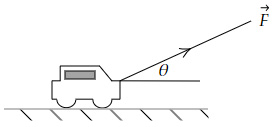
As a result, the toy car accelerates uniformly for time $t$. What is the work done on the toy car by the boy in time $t$? (Assume the mass of the car is $m$.)
$\dfrac{F^2 t^2}{m} \cos θ$ | |
$\dfrac{1}{2} \dfrac{F^2 t^2}{m} \cos^2 θ$ | |
$\dfrac{1}{4} \dfrac{F^2 t^2}{m} \sin 2θ$ | |
$\dfrac{F^2 t^2}{m} \cos 2θ$ |
Question 2 Explanation:
Since the toy car starts from rest:
$s = \dfrac{1}{2} at^2$
And, $F \cos θ = ma → a = \dfrac{F}{m} \cos θ$
$s = \dfrac{1}{2} \dfrac{Ft^2}{m} \cos θ$
Work done $= Fs \cos θ$ $ = \dfrac{1}{2} \dfrac{F^2 t^2}{m} \cos ^2 θ$
$s = \dfrac{1}{2} at^2$
And, $F \cos θ = ma → a = \dfrac{F}{m} \cos θ$
$s = \dfrac{1}{2} \dfrac{Ft^2}{m} \cos θ$
Work done $= Fs \cos θ$ $ = \dfrac{1}{2} \dfrac{F^2 t^2}{m} \cos ^2 θ$
Question 3 |
Zack releases an object of mass $4\ kg$ from a height of 6 m from the ground level. The object loses $15\ J$ of energy due to frictional forces acting on it. What is the velocity when the object reaches the other side of the curve?
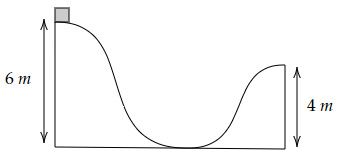
$5.7\ m/s$ | |
$5.2\ m/s$ | |
$4.9\ m/s$ | |
$4.4\ m/s$ |
Question 3 Explanation:
[Using $m = 4\ kg, g = 10\ m/s^2, $ $ h_1 = 6\ m $ and $ h_2 = 4 m$]
Initial energy
$= mgh_1 = 4×10×6 = 240\ J$
Energy on the other side
$= 240-15 = 225\ J$
Potential energy on the other side
$= mgh_2 = 4×10×4 = 160\ J$
Kinetic energy on the other side
$= 225-160 = 65\ J$
Velocity of the object
$= \sqrt{ \dfrac{2KE}{m}} = \sqrt { \dfrac{2 × 65}{4}} $ $ = 5.70\ m/s$
Initial energy
$= mgh_1 = 4×10×6 = 240\ J$
Energy on the other side
$= 240-15 = 225\ J$
Potential energy on the other side
$= mgh_2 = 4×10×4 = 160\ J$
Kinetic energy on the other side
$= 225-160 = 65\ J$
Velocity of the object
$= \sqrt{ \dfrac{2KE}{m}} = \sqrt { \dfrac{2 × 65}{4}} $ $ = 5.70\ m/s$
Question 4 |
A gun fires a bullet of mass $m$ towards a solid target with a speed $u$. The bullet pierces the target, slowly loses energy, and comes to rest. The bullet loses energy approximately equal to the work done by the frictional forces. If the effective coefficient of friction is $μ$, then the rate of loss of energy (with time) is,
$\dfrac{4mug}{μ}$ | |
$2muμg$ | |
$\dfrac{1}{2} \dfrac{mug}{μ}$ | |
$\dfrac{1}{2} muμg$ |
Question 4 Explanation:
Initial kinetic energy $= \dfrac{1}{2} mu^2$
Frictional Force $≈ μmg$
Deceleration $a = μg$
Time for velocity to reach $0$ is $t = \dfrac{u}{μg}$
Final energy $= 0$
Rate of loss of energy = Energy lost ÷ Time taken for the loss
$= \dfrac{1}{2} mu^2 ÷ \dfrac{u}{μg}$
$= \dfrac{1}{2} muμg$
Frictional Force $≈ μmg$
Deceleration $a = μg$
Time for velocity to reach $0$ is $t = \dfrac{u}{μg}$
Final energy $= 0$
Rate of loss of energy = Energy lost ÷ Time taken for the loss
$= \dfrac{1}{2} mu^2 ÷ \dfrac{u}{μg}$
$= \dfrac{1}{2} muμg$
Question 5 |
An object of mass $M$ compresses the length of a spring by $y$. It is then released, and the object thus travels a distance $l$ on a rough surface. If the spring is compressed by $4y$, then the distance travelled by the object would be,
$64\,l$, because $l$ is proportional to the 3rd power of $y$ | |
$8\,l$, because $l$ is proportional to the 1st power of $y$ | |
$16\,l$, because $l$ is proportional to the 2nd power of $y$ | |
$4\,l$, because $l$ is independent of $y$ |
Question 5 Explanation:
Initial energy $= \dfrac{1}{2} ky^2 = \dfrac{1}{2} mu^2$
Since the final velocity is 0 and the object moves with a constant deceleration,
$u^2 = 2al $
$→y^2 ∝ u^2 ∝ l$
Thus,
$ \dfrac{l^{'}}{l} = \dfrac{16y^2}{y^2} → l' = 16\,l $
Since the final velocity is 0 and the object moves with a constant deceleration,
$u^2 = 2al $
$→y^2 ∝ u^2 ∝ l$
Thus,
$ \dfrac{l^{'}}{l} = \dfrac{16y^2}{y^2} → l' = 16\,l $
Question 6 |
A position-dependent force $F$ acts on a 1D system, as shown below.
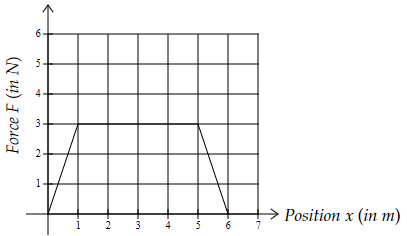
What is the work done on the system by the position-dependent force?
$15\ J$ | |
$23\ J$ | |
$30\ J$ | |
$35\ J$ |
Question 6 Explanation:
Work done by the force = Area under the curve (for 1D)
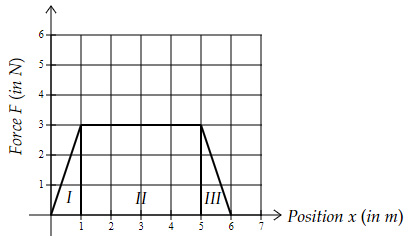
Area under the curve = Area of I + Area of II + Area of III
Area under the curve
$= \dfrac{1}{2}×1×3+3×4 $ $ +\dfrac{1}{2}×1×3$ $= 15 J$

Area under the curve = Area of I + Area of II + Area of III
Area under the curve
$= \dfrac{1}{2}×1×3+3×4 $ $ +\dfrac{1}{2}×1×3$ $= 15 J$
Question 7 |
Questions 7 and 8 are based on the below information.
Hannah sets a conical pendulum in motion. The radius of the pendulum is $l$, its speed is $v$, and the length of the string is $5l$.
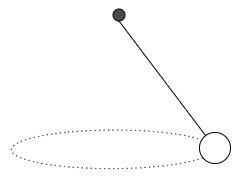
What is the work done by the tension force on the pendulum?
$10\ J$ | |
$0\ J$ | |
$-10\ J$ | |
$3\ J$ |
Question 7 Explanation:
The tension force is perpendicular to the direction of motion.
Thus, the work done on the pendulum is $0\ J$.
Thus, the work done on the pendulum is $0\ J$.
Question 8 |
Hannah sets a conical pendulum in motion. The radius of the pendulum is $l$, its speed is $v$, and the length of the string is $5l$.

Hannah now spins the pendulum more rapidly, and as a result, the pendulum rises. The speed is now $2v$ and the radius is now $2l$. What is the difference between the old and the new energy of the pendulum?
$1.5\ mv^2+0.42\ mgl$ | |
$mv^2+0.50\ mgl$ | |
$1.5\ mv^2+0.31\ mgl$ | |
$2\ mv^2+0.28\ mgl$ |
Question 8 Explanation:
Initial energy of the pendulum
$= \dfrac{1}{2} mv^2-mgh_1$
(Choosing the reference point as the top of the pendulum)
Final energy of the pendulum
$= 2\ mv^2-mgh_2$
Difference $= \dfrac{3}{2} mv^2+mg(h_1-h_2)$
And, $h_1 = \sqrt{25l^2-l^2} = \sqrt{24}\ l$
$h_2 = \sqrt{25l^2-4l^2} = \sqrt{21}\ l$
Thus, difference $= 1.5\ mv^2+0.31\ mgl$
$= \dfrac{1}{2} mv^2-mgh_1$
(Choosing the reference point as the top of the pendulum)
Final energy of the pendulum
$= 2\ mv^2-mgh_2$
Difference $= \dfrac{3}{2} mv^2+mg(h_1-h_2)$
And, $h_1 = \sqrt{25l^2-l^2} = \sqrt{24}\ l$
$h_2 = \sqrt{25l^2-4l^2} = \sqrt{21}\ l$
Thus, difference $= 1.5\ mv^2+0.31\ mgl$
Question 9 |
A block of mass $2.4\ kg$ is sliding down a rough incline plane at a constant speed of $4\ m/s$.
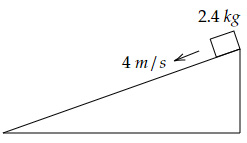
The angle of the incline with the horizontal is $30°$. What is the power delivered by the gravitational force on the block?
$52\ W$ | |
$38\ W$ | |
$89\ W$ | |
$48\ W$ |
Question 9 Explanation:
Angle between the gravitational force and the velocity of the block
$= 90°-30° = 60°$
Gravitational force
$= 2.4×10 = 24\ N$
Power delivered
$= 24×4×\cos 60° = 48\ W$
$= 90°-30° = 60°$
Gravitational force
$= 2.4×10 = 24\ N$
Power delivered
$= 24×4×\cos 60° = 48\ W$
Question 10 |
Which of the below graphs shows the kinetic energy of a mass attached to a spring as a function of its position?
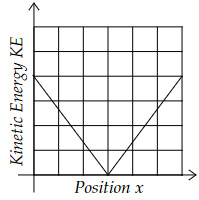 | |
 | |
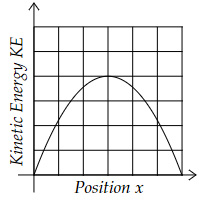 | |
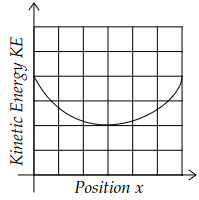 |
Question 10 Explanation:
Kinetic energy of the spring mass system
$= E- \dfrac{1}{2} k(x-x_o )^2$
(Where $E$ is the total energy and $x_o$ is the equilibrium position.)
Thus, at the end points the $KE$ is minimum and at equilibrium the $KE$ is maximum.
And the dependence is of parabolic nature thus, Option C is correct.
$= E- \dfrac{1}{2} k(x-x_o )^2$
(Where $E$ is the total energy and $x_o$ is the equilibrium position.)
Thus, at the end points the $KE$ is minimum and at equilibrium the $KE$ is maximum.
And the dependence is of parabolic nature thus, Option C is correct.
Question 11 |
A block of mass $1.5\ kg$ is moving at a speed of $3.5\ m/s$. It suddenly passes through a rough patch, and its speed decreases to $2\ m/s$ after coming out from the patch. In what form has the kinetic energy of the block converted into, and how much?
Thermal energy, $6.19\ J$ | |
Kinetic energy, $7.20\ J$ | |
Potential energy, $12.4\ J$ | |
Thermal energy, $8.85\ J$ |
Question 11 Explanation:
[Using $m = 1.5\ kg, v_2 = 3.5\ m/s \ $ and $ \ v_1 = 2\ m/s$]
Work done $= ΔKE$
$= \dfrac{1}{2} m(v_2^2-v_1^2)$
$= 6.19\ J$
Frictional losses increase the temperature of the surfaces. So, energy is converted into heat (or thermal energy).
Work done $= ΔKE$
$= \dfrac{1}{2} m(v_2^2-v_1^2)$
$= 6.19\ J$
Frictional losses increase the temperature of the surfaces. So, energy is converted into heat (or thermal energy).
Question 12 |
Chole throws two stones of different masses, horizontally with a speed of $10\ m/s$ and $14\ m/s$, respectively. She is standing at a height of $5\ m$ from the ground. Which of these below statements is correct?
Change in potential energy is the same | |
Work done by gravity is the same in both the cases | |
Velocity of these stones must be the same when they reach the ground | |
Both stones reach the ground at the same time |
Question 12 Explanation:
Potential energy change is dependent on the mass.
Option A → False
Change in potential energy is the same as work done by gravity.
Option B → False
Velocity cannot be the same as they both have unequal initial velocities.
Option C → False
Acceleration due to gravity is the same for both and each have 0 initial velocity in the vertical direction. So, Time taken must be the same.
Option D → True
Option A → False
Change in potential energy is the same as work done by gravity.
Option B → False
Velocity cannot be the same as they both have unequal initial velocities.
Option C → False
Acceleration due to gravity is the same for both and each have 0 initial velocity in the vertical direction. So, Time taken must be the same.
Option D → True
Question 13 |
A simple pendulum swings with a time period of $t\ sec$. Which of the below statements regarding the pendulum is incorrect?
(Assume there is no air drag acting on the pendulum.)

The velocity of the pendulum is minimum at the end points | |
The acceleration of the pendulum at each point is equal to $g$ | |
The total energy of the pendulum is a constant | |
The kinetic energy of the pendulum is maximum at the lowest point |
Question 13 Explanation:
The kinetic energy is minimum at the end points.
Option A → True
The acceleration of the pendulum changes at each point.
Option B → False
The pendulum swings with the same energy if frictional losses are 0.
Option C → True
The kinetic energy is maximum at the lowest point of motion.
Option D → True
Option A → True
The acceleration of the pendulum changes at each point.
Option B → False
The pendulum swings with the same energy if frictional losses are 0.
Option C → True
The kinetic energy is maximum at the lowest point of motion.
Option D → True
Question 14 |
Archie shoots an arrow at the top of a pole fixed at one end, as shown below.

The arrow pierces the top side of the pole (with negligible loss in energy) and as a result, the system (arrow + pole) rotates by a quarter of the circle together. By what angle $θ$ does the system turn when the velocity of the system is $1.5v_1$?
(Assume the pole has negligible mass and note, if $\cos\ θ = A → θ = \cos^{-1}A$.)
$ \cos^{-1} \left(1-0.65 \dfrac {gl}{v_1^2}\right)$ | |
$ \cos^{-1} \left(1-0.5 \dfrac {v_1^2}{gl}\right)$ | |
$ \cos^{-1} \left(1-0.625 \dfrac {v_1^2}{gl}\right)$ | |
$ \cos^{-1} \left(0.4 \dfrac {v_1^2}{gl}\right)$ |
Question 14 Explanation:
Initial energy $= m_1 gl+\dfrac{1}{2} m_1 v_1^2$
When the system rotates by an angle $θ$,
Energy $= m_1 gl\ cosθ+\dfrac{1}{2} m_1 (1.5v_1)^2$
$= m_1 gl\ cosθ+1.125m_1 v_1^2$
Since, energy loss is negligible,
$m_1 gl+0.5m_1 v_1^2 $ $ = m_1 gl\ cosθ+1.125m_1 v_1^2$
$m_1 gl(1-cosθ ) = 0.625m_1 v_1^2$
$cosθ = (1-0.625 \dfrac{v_1^2}{gl})$
$→ θ = cos^{-1}(1-0.625 \dfrac{v_1^2}{gl})$
When the system rotates by an angle $θ$,
Energy $= m_1 gl\ cosθ+\dfrac{1}{2} m_1 (1.5v_1)^2$
$= m_1 gl\ cosθ+1.125m_1 v_1^2$
Since, energy loss is negligible,
$m_1 gl+0.5m_1 v_1^2 $ $ = m_1 gl\ cosθ+1.125m_1 v_1^2$
$m_1 gl(1-cosθ ) = 0.625m_1 v_1^2$
$cosθ = (1-0.625 \dfrac{v_1^2}{gl})$
$→ θ = cos^{-1}(1-0.625 \dfrac{v_1^2}{gl})$
Question 15 |
A car loses its break and needs to slow down to prevent an accident. The driver takes the car on a rough patch so that it slows down due to frictional forces. The mass of the car is $1{,}700\ kg$ and the initial velocity of the car is $25\ m/s$. It takes the car $80\ s$ to stop completely. What is the average power delivered to the car by the frictional forces?
$6640\ W$ | |
$6330\ W$ | |
$6260\ W$ | |
$6890\ W$ |
Question 15 Explanation:
Deceleration of the car
$= \dfrac{25 - 0}{80} = 0.3125\ m/s^2$
Distance covered by the car
$= \dfrac{1}{2}×0.3125×80^2 $ $ = 1000\ m$
Force on the car
$= 1700×0.3125 $ $ = 531.25\ N$
Work done on the car by the frictional forces
$= 531.25×1000 $ $ = 531250\ J$
Power delivered
$= \dfrac{531250}{80} = 6640\ W$
$= \dfrac{25 - 0}{80} = 0.3125\ m/s^2$
Distance covered by the car
$= \dfrac{1}{2}×0.3125×80^2 $ $ = 1000\ m$
Force on the car
$= 1700×0.3125 $ $ = 531.25\ N$
Work done on the car by the frictional forces
$= 531.25×1000 $ $ = 531250\ J$
Power delivered
$= \dfrac{531250}{80} = 6640\ W$
Once you are finished, click the button below. Any items you have not completed will be marked incorrect.
There are 15 questions to complete.
|
List |
Next Practice Test:
Unit 5: Momentum >>
AP Physics 1 Main Menu >>
